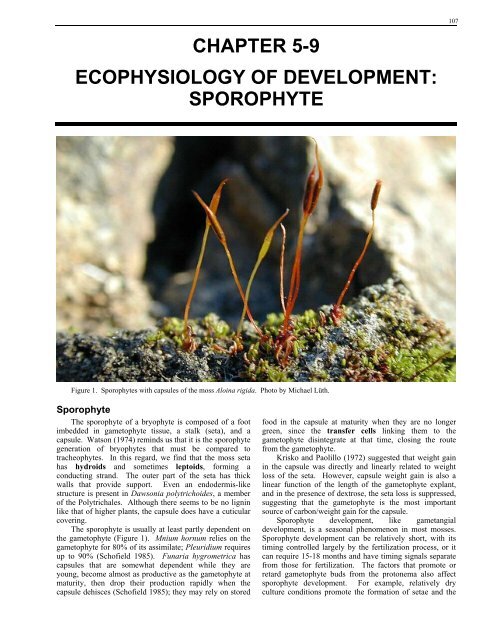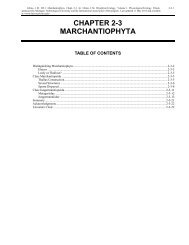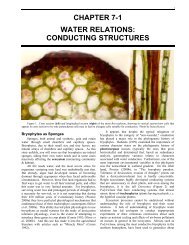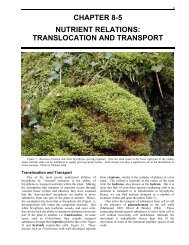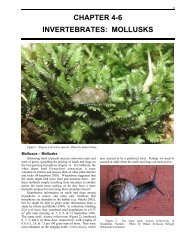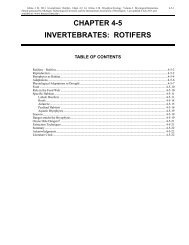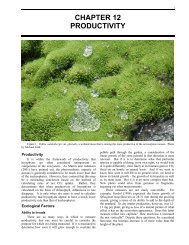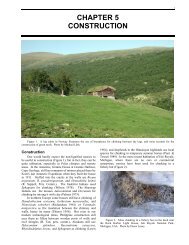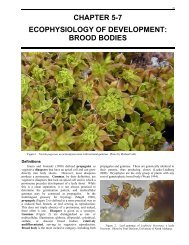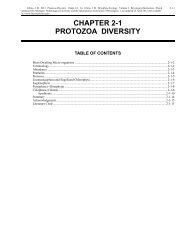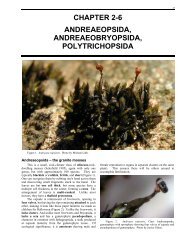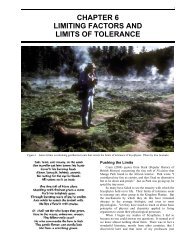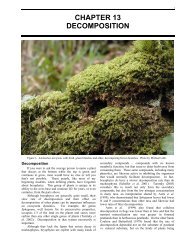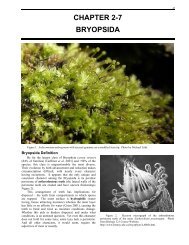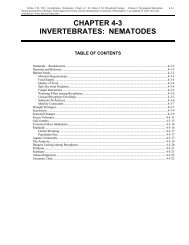chapter 5-9 ecophysiology of development: sporophyte - Bryophyte ...
chapter 5-9 ecophysiology of development: sporophyte - Bryophyte ...
chapter 5-9 ecophysiology of development: sporophyte - Bryophyte ...
You also want an ePaper? Increase the reach of your titles
YUMPU automatically turns print PDFs into web optimized ePapers that Google loves.
CHAPTER 5-9ECOPHYSIOLOGY OF DEVELOPMENT:SPOROPHYTE107Figure 1. Sporophytes with capsules <strong>of</strong> the moss Aloina rigida. Photo by Michael Lüth.SporophyteThe <strong>sporophyte</strong> <strong>of</strong> a bryophyte is composed <strong>of</strong> a footimbedded in gametophyte tissue, a stalk (seta), and acapsule. Watson (1974) reminds us that it is the <strong>sporophyte</strong>generation <strong>of</strong> bryophytes that must be compared totracheophytes. In this regard, we find that the moss setahas hydroids and sometimes leptoids, forming aconducting strand. The outer part <strong>of</strong> the seta has thickwalls that provide support. Even an endodermis-likestructure is present in Dawsonia polytrichoides, a member<strong>of</strong> the Polytrichales. Although there seems to be no ligninlike that <strong>of</strong> higher plants, the capsule does have a cuticularcovering.The <strong>sporophyte</strong> is usually at least partly dependent onthe gametophyte (Figure 1). Mnium hornum relies on thegametophyte for 80% <strong>of</strong> its assimilate; Pleuridium requiresup to 90% (Sch<strong>of</strong>ield 1985). Funaria hygrometrica hascapsules that are somewhat dependent while they areyoung, become almost as productive as the gametophyte atmaturity, then drop their production rapidly when thecapsule dehisces (Sch<strong>of</strong>ield 1985); they may rely on storedfood in the capsule at maturity when they are no longergreen, since the transfer cells linking them to thegametophyte disintegrate at that time, closing the routefrom the gametophyte.Krisko and Paolillo (1972) suggested that weight gainin the capsule was directly and linearly related to weightloss <strong>of</strong> the seta. However, capsule weight gain is also alinear function <strong>of</strong> the length <strong>of</strong> the gametophyte explant,and in the presence <strong>of</strong> dextrose, the seta loss is suppressed,suggesting that the gametophyte is the most importantsource <strong>of</strong> carbon/weight gain for the capsule.Sporophyte <strong>development</strong>, like gametangial<strong>development</strong>, is a seasonal phenomenon in most mosses.Sporophyte <strong>development</strong> can be relatively short, with itstiming controlled largely by the fertilization process, or itcan require 15-18 months and have timing signals separatefrom those for fertilization. The factors that promote orretard gametophyte buds from the protonema also affect<strong>sporophyte</strong> <strong>development</strong>. For example, relatively dryculture conditions promote the formation <strong>of</strong> setae and the
108 Chapter 5-9: Ecophysiology <strong>of</strong> Development: Sporophytetransformation <strong>of</strong> the callus into sporangia inPhyscomitrium pyriforme (Bauer 1963). However,<strong>sporophyte</strong> <strong>development</strong> can require environmentalcharacteristics that contrast sharply with those used forgametophyte growth. This permits energy to be divertedinto the <strong>sporophyte</strong>.A case in point is that <strong>of</strong> the moss Physcomitrellapatens. At 15ºC and 8-hour photoperiod (20 µmol m -2 s -1 )– conditions simulating spring – it produced the highestnumber <strong>of</strong> <strong>sporophyte</strong>s in the lab, but at 25ºC and a 16-hourphotoperiod – conditions simulating summer – that numberwas greatly reduced (Hohe et al. 2002). Predictably, thevegetative growth was reduced under conditions favoring<strong>sporophyte</strong> production; one can assume that this was due tonutrient transfer to the developing <strong>sporophyte</strong>. It appearsthat the MADS-box gene PpMADS-S is involved in this<strong>sporophyte</strong> production, as the RNA production associatedwith it was 2-3 times higher during the conditions thatstimulated <strong>sporophyte</strong> <strong>development</strong>.Once fertilization occurs, this one-time egg, nowzygote, continues <strong>development</strong> to look not like its parenttissue, but like a <strong>sporophyte</strong>. What is it that makes tissuebecome <strong>sporophyte</strong> instead <strong>of</strong> gametophyte? True, thereare two sets <strong>of</strong> chromosomes, but there is no new or uniqueinformation in those two sets as opposed to one, onlydifferent combinations and ways <strong>of</strong> expressing genes forthe same type <strong>of</strong> trait. A most striking bit <strong>of</strong> evidenceregarding control <strong>of</strong> <strong>sporophyte</strong> <strong>development</strong> is the ability<strong>of</strong> kinetin to stimulate the production <strong>of</strong> <strong>sporophyte</strong> budson the protonema, at least in Physcomitrium (Menon & Lal1974). But something has to determine that such kinetin isavailable to be the stimulus. Perhaps we can gain someinsight from examining experiments with callus tissue thatinduce it to become gametophyte or <strong>sporophyte</strong> incharacter. Bopp (1968) has elaborated on the physiologicalconditions that determine the life cycle stage developingfrom callus tissue. At concentrations above 1 g/l <strong>of</strong> glucoseonly <strong>sporophyte</strong>s form from <strong>sporophyte</strong> callus. With nosugar, this same <strong>sporophyte</strong> callus produces gametophytes,as does gametophyte callus. The most intriguing andinformative event is that with the addition <strong>of</strong> sugar orcoconut milk, a gametophyte callus will produce<strong>sporophyte</strong>s. Clearly, it is not the kind <strong>of</strong> informationgained by the second set <strong>of</strong> chromosomes that makes thedifference.One can easily imagine how these responses couldrelate to effects <strong>of</strong> surrounding tissues. Isolated cells mustbe self-sufficient in their production <strong>of</strong> glucose, whereas acell (zygote) retained within an archegonium can use theresources <strong>of</strong> the rest <strong>of</strong> the plant. If sugar has already beenmobilized for gametogenesis and fertilization, the zygotecan easily become a target for this resource. In fact, couldit be that the dividing embryo behaves physiologically likea dividing meristem? In tracheophytes, actively dividingcells <strong>of</strong> meristematic regions typically result in themetabolism <strong>of</strong> starch to glucose and the mobilization <strong>of</strong>glucose to the dividing cells. If dividing embryo cells sendthe same message as dividing meristems, one would expectthe same arrival <strong>of</strong> sugars to these cells. Had the zygotebeen shed from the parent plant before the cells began todivide, as is the case in the algae, these food reserves wouldnot have been available.Control <strong>of</strong> GenerationIt is normally the case that the embryo, safely insidethe archegonial tissues and in constant contact with itsparent, will develop into a foot, stalk, and capsule atop thegametophyte. However, in early and cleverly designedexperiments, Pringsheim was able to regenerategametophytic structures from sporophytic tissue (Bryan2001), evidence that the environment, not the duplication<strong>of</strong> genetic information, is the dominant force indetermining what the generation will look like. Thus wecan be certain that the parent tissues are supplying thisspecial environment and most likely influencing the<strong>development</strong> <strong>of</strong> the embryo by controlling moisture, light,nutrients, energy availability, and hormones, at the veryleast.Arnaudow (1925) performed tedious experiments inwhich gametophyte tissue was placed into the archegonium<strong>of</strong> a moss. By doing this, he showed that a gametophyte soplaced could develop the morphological characteristics <strong>of</strong> a<strong>sporophyte</strong>. Meiosis, <strong>of</strong> course, would fail due to the lack<strong>of</strong> pairs unless the moss happened to be polyploid. He thenreversed the procedure and removed zygotes from thearchegonium to develop without the influence <strong>of</strong>gametophyte tissue. These developed into gametophytes.This evidence supports the homology theory that bothgenerations are essentially the same. It is the<strong>development</strong>al environment that differs.Seta ElongationIn liverworts, the capsule forms and then the setaelongates (Figure 2, Figure 3). In mosses, it is the reverse;setae elongate and then the capsule forms (Figure 4, Figure5). In Sphagnum, as well as in some <strong>of</strong> the Bryopsida, theseta fails to elongate. However, unlike the Bryopsida, inSphagnum the gametophyte forms a pseudopodium thatelongates after the capsule matures (Figure 6).Figure 2. Maturing <strong>sporophyte</strong> <strong>of</strong> the leafy liverwortLophocolea heterophylla before seta elongation. Photo by PaulDavison, University <strong>of</strong> North Alabama.
Chapter 5-9: Ecophysiology <strong>of</strong> Development: Sporophyte 109Figure 3. Elongated setae on Lophocolea heterophylla.Photo by Jan-Peter Frahm.Figure 4. Young <strong>sporophyte</strong>s <strong>of</strong> the moss Funariahygrometrica with setae and calyptrae, but no capsules yet. Photoby Michael Lüth.Figure 5. Mature capsules <strong>of</strong> Funaria hygrometrica. Photoby Michael Lüth.Thomas et al. (1970) found that liverwort setaerespond in a manner similar to that <strong>of</strong> stems in higherplants; elongation <strong>of</strong> setae in Lophocolea was promoted bylow concentrations <strong>of</strong> IAA and inhibited at higher ones.Soon after that, Kaufman et al. (1982) determined that cellsin the stalk <strong>of</strong> Conocephalum conicum and seta <strong>of</strong> Pelliaepiphylla exhibited acid growth, much like that <strong>of</strong> Avena(oats), implicating involvement <strong>of</strong> IAA.The pseudopodium (actually gametophyte tissue, notequivalent to a seta) <strong>of</strong> Sphagnum palustre (Figure 6) alsoshows rapid growth in low IAA concentrations (0.01 ppm)but no growth at higher ones (0.5, 1.0 ppm) (Patterson1957). The pseudopodia grows even longer in lowconcentrations than in the controls. But Patterson found apuzzling lack <strong>of</strong> response at any concentration <strong>of</strong> IAA bysetae <strong>of</strong> Frullania inflata and F. tamarisci ssp. asagrayana.Figure 6. Upper: Capsules <strong>of</strong> Sphagnum beforepseudopodium elongation. Photo by Zen Iwatsuki. Lower:Elongated pseudopodia <strong>of</strong> Sphagnum palustre. Photo by JaniceGlime.While comparing the responses <strong>of</strong> two liverworts,Pellia epiphylla (Figure 8) and Conocephalum conicum(Figure 7), to that <strong>of</strong> oats, Kaufman and coworkers (1982)discovered that a tenfold increase in the growth rate <strong>of</strong> oats(Avena) internodes appeared about three hours afterapplication <strong>of</strong> 10 -5 M GA 3 , but that 10 -5 M IAA had noeffect. On the other hand, in the liverworts, the setaeresponded to 10 -5 M IAA with a two-fold increase in growthrate within 10-15 minutes. Thomas et al. (1982)demonstrated the production <strong>of</strong> auxin (IAA) and ethyleneby cells <strong>of</strong> elongating setae <strong>of</strong> Pellia epiphylla, addingmore support to the suggestion that at least IAA mayexercise control over seta elongation, and that mostprobably IAA and ethylene operate in tandem to controlseta growth (Thomas et al. 1983).IAA may play another important role in the seta.Thomas et al. (2002), using radioactively labelled IAA andinfrared video recording <strong>of</strong> Pellia epiphylla setae, haveshown that IAA in donor blocks moved preferentially to thelower sides <strong>of</strong> horizontally placed setae. Upwardgravitropic curvature occurred within 50-60 minutes, whilegrowth rates on the top side <strong>of</strong> the setae dropped (seeFigure 8).
110 Chapter 5-9: Ecophysiology <strong>of</strong> Development: SporophyteFigure 7. Archegoniophores <strong>of</strong> Conocephalum conicum.Photo by Janice Glime.Figure 9. Young <strong>sporophyte</strong>s on Lophocolea heterophylla.Photo by Michael Lüth.At least some mosses exhibit tropisms in their setae,but little is known <strong>of</strong> the mechanisms in this organ. InOligotrichum hercynicum, setae bend upward, most likelywith a gravitropic response, but possibly also with a lightresponse (Figure 10)Figure 8. Elongated setae <strong>of</strong> Pellia neesiana. Note thegenerally upright positions <strong>of</strong> the setae despite the nearly 45ºslope <strong>of</strong> the substrate. Photo by Janice Glime.Consistent with cell elongation in many other plantorgans, the seta cells <strong>of</strong> the leafy liverwort Lophocoleaheterophylla (Figure 9) increased their osmotic potential to-6 bars, concomitantly experiencing a 16-fold increase inwater content, and consequently in length (Thomas 1977).This increase in osmotic potential followed a period inwhich osmotic potentials were as low as -29 to -37 bars inunelongated seta cells. In this species, at least, the setaelongates as a simple expansion <strong>of</strong> individual cells(Thomas & Doyle 1976). These cells experienced a 25-fold increase in length while increasing cell wallcarbohydrate by only 2-fold. Nevertheless, starchdiminishes during elongation, and polyfructosans andsucrose are replaced by fructose and glucose, suggestingthat in addition to transport <strong>of</strong> wall precursors from thegametophyte, carbohydrate reserves in seta cells supplysome <strong>of</strong> the structural materials needed for elongation.The elongation <strong>of</strong> the seta <strong>of</strong> Lophocolea heterophyllaoccurs through rapid cell elongation with no net lipid loss(Thomas 1975). Rather, lipids are converted fromglycerolipids and sterol esters in the unelongated seta tophospho- and glycolipids during elongation. At this time,unusual polyunsaturated fatty acids such as arachidonic andeicosapentaenoic acids appear.Temperature is also important in seta elongation. InAtrichum undulatum, seta cells in 12-22°C were three timeslonger than those in 3-12°C (Stevenson et al. 1972). Setae<strong>of</strong> Pellia epiphylla, though, grew longer in coolertemperatures (5°C) (Slade 1965). Those at highertemperatures did have a faster growth rate but the overalllength was less.Figure 10. Upward bending <strong>of</strong> the setae <strong>of</strong> Oligotrichumhercynicum, most likely as a gravitropic response. Photo byMichael Lüth.Energy SourceThe young <strong>sporophyte</strong> is mostly dependent on thegametophyte for energy and nutrients. Transfer cellsoccur at the juncture <strong>of</strong> the gametophyte and <strong>sporophyte</strong>and are typically endowed with extensive wall labyrinths(Figure 12) with trapped pockets <strong>of</strong> cytoplasm in theepidermal cells <strong>of</strong> the <strong>sporophyte</strong> foot (Figure 11; Lal &Chauhan 1981). Electron microscopy has revealed theselabyrinths in such widely divergent taxa as Funariahygrometrica (Monroe 1965b; Wiencke & Schulz 1975;Browning & Gunning 1977, 1979), Physcomitriumcyathicarpum (Lal & Chauhan 1981), Mnium (Eymé &Suire 1967), Polytrichum (Maier 1967), Dawsonia andDendroligotrichum (Hébant 1975), and Sphaerocarpos(Kelley 1969). Although the labyrinth begins <strong>development</strong>during seta elongation, maximum <strong>development</strong> occursduring meiosis (Lal & Chauhan 1981). These transfer cellsare a site <strong>of</strong> intense enzyme activities (Lal & Chauhan1981), especially phosphatases that activate ATP (Maier &Maier 1972), and facilitate transfer <strong>of</strong> substances betweenthe two generations, or at least from gametophyte to<strong>sporophyte</strong>. Wiencke and Schulz (1975) demonstrated thatthere is some division <strong>of</strong> labor, with the basal part <strong>of</strong> the
Chapter 5-9: Ecophysiology <strong>of</strong> Development: Sporophyte 111foot mainly participating in water uptake from thegametophyte and the middle part mainly absorbingnutrients. Radiolabelled sucrose is known to travel bothdirections in these leptoids in Polytrichum commune(Eschrich 1975).Figure 11. Junction <strong>of</strong> gametophyte and <strong>sporophyte</strong> showinghaustorial foot <strong>of</strong> <strong>sporophyte</strong>. Drawn from Lal & Chauhan(1981).(Arnell 1905), spanning a multitude <strong>of</strong> environmentalconditions. When embryo <strong>development</strong> begins,environmental conditions can easily be less than favorablefor photosynthetic activity. Patterson and Baber (1961)found that many temperate mosses were dormant in latesummer and autumn. Such a dormant period, if it affectsthe <strong>sporophyte</strong> as well, greatly reduces its opportunity toprovide its own food. The <strong>sporophyte</strong> furthermore haslittle exposed surface area for photosynthesis, and whatsurface there is, at least throughout most <strong>of</strong> the<strong>development</strong>, has its long axis oriented in the samedirection as the light, thus minimizing its utility as a lightabsorbingorgan. It is reasonable, then, that thegametophyte, which is sensitive to moisture that must beavailable for growth and that has a large photosyntheticsurface, can provide the food and the signals for the<strong>sporophyte</strong>. Hughes (1954) has demonstrated that it is thegametophyte and not the <strong>sporophyte</strong> that responds tophotoperiod to control <strong>sporophyte</strong> <strong>development</strong> inPogonatum aloides and Polytrichum piliferum.In Fontinalis most species in the northeastern UnitedStates have mature gametangia in the autumn. This meansthat <strong>sporophyte</strong> <strong>development</strong> begins as the temperaturesdrop for winter (Figure 13). During my field observationsin New Hampshire, capsule maturity in Fontinalis novaeangliaeoccurred between February and April. By the end<strong>of</strong> April the capsules were gone. Under these coldconditions, productivity is reduced, although the greaterlight availability may <strong>of</strong>fset this low temperature effectsomewhat. By drawing on the reserves <strong>of</strong> the gametophyte,sufficient food could be provided for the wintertimecapsule <strong>development</strong>.Figure 12. Foot epidermal cell showing labyrinth in cell wall<strong>of</strong> Physcomitrium cyathicarpum. Drawing based on electronphotomicrograph in Lal & Chauhan (1981).Whereas the seta is little more than naked stem tissuerequiring minimal resources, the formation <strong>of</strong> the capsulecan be expected to have a high energy cost. Taylor andcoworkers (1972) have shown that in several liverworts the<strong>sporophyte</strong> has a higher concentration <strong>of</strong> chlorophyll thandoes the gametophyte. Yet the excised <strong>sporophyte</strong> requiresan exogenous carbon source, suggesting that it isnevertheless dependent on the gametophyte for at least part<strong>of</strong> its resources. Courtice and coworkers (1978) haveshown that sugars move from the gametophyte to the<strong>sporophyte</strong> in Physcomitrella. Apparently the demands <strong>of</strong>the <strong>sporophyte</strong> are greater than its own production capacity.If we put these demands into an ecological and temporalcontext, the need for a gametophytic supplement becomesobvious. For example, <strong>sporophyte</strong>s <strong>of</strong> Polytrichum canrequire up to 13 months to develop in some localitiesFigure 13. Seasonal cycle <strong>of</strong> Fontinalis dalecarlica and F.novae-angliae. Drawing by Janice Glime.In Polytrichum juniperinum and P. ohioense, thecapsule takes weight from the seta in culture if no dextroseis supplied to the capsule, but little seta loss occurs in thepresence <strong>of</strong> dextrose (Krisko & Paolillo 1972). Whenphotosynthetic <strong>sporophyte</strong> and gametophyte cultures <strong>of</strong>Physcomitrium pyriforme and Funaria hygrometrica aremaintained, only the gametophyte is autotrophic. Glucoseor some other sugar must be supplied to the <strong>sporophyte</strong> orall new growth lacks chlorophyll, produces a yellow wallpigment, and dies (Bauer 1963; Krupa 1969). Theseexamples all seem to demonstrate the high energyrequirement <strong>of</strong> the capsule and its dependence on thegametophyte.
112 Chapter 5-9: Ecophysiology <strong>of</strong> Development: SporophyteThe Anthocerotophyta may have rather differentenergy availability from that <strong>of</strong> the mosses and liverworts.Thomas et al. (1978) found that the <strong>sporophyte</strong>s had aphotosynthetic rate almost double that <strong>of</strong> the gametophyteson a fresh weight basis. They estimated that this wassufficient for maintenance but that supplementation fromthe gametophyte was needed for growth. They found thatthis transfer from the gametophyte was facilitated byenzymatic activity in the transfer cells. The carbontransferred ultimately accumulated in the spores.If photosynthate from the gametophyte is required for<strong>sporophyte</strong> <strong>development</strong>, why is there such a highchlorophyll content in the developing <strong>sporophyte</strong>? Wecould blame the imperfections <strong>of</strong> evolution for thisphenomenon. If the <strong>sporophyte</strong> is genetically the same asthe gametophyte, it has the potential to form chlorophyll. Ithas the light necessary. Perhaps no mechanism hasevolved to suppress it. Or could it be a mask againstultraviolet light and high light intensity that couldotherwise damage dividing cells during sporogenesis?Proctor (1977) found that the capsule does indeedcontribute considerably to the photosynthesis and energyneeds <strong>of</strong> the <strong>sporophyte</strong>, providing 10-50% <strong>of</strong> the energyneeded for capsule <strong>development</strong> while it is still green.Perhaps it is just that an extraordinarily high energyrequirement for producing spores requires not only theenergy <strong>of</strong> <strong>sporophyte</strong> photosynthesis, but also thattransferred from the gametophyte. The resulting sporesmust carry sufficient energy to remain viable, even totravel, for long periods before producing the protonemalthread that permits them to once more be photosynthetic.LightEarly in its life the capsule is green and photosynthetic,typically gaining phenolic compounds that color it withage. Eventually it loses its photosynthetic capability anddepends on stored reserves and sometimes thegametophyte. This ability to photosynthesize obviouslyrequires light.It is interesting that the translocation <strong>of</strong> carbohydrates(as glucose) to the <strong>sporophyte</strong> <strong>of</strong> Funaria hygrometricaoccurs in response to light (French & Paolillo 1976).French and Paolillo found that capsule morphology <strong>of</strong> wasabnormal in the dark because the spore sac failed toexpand. Relatively low light intensity corrected theseproblems, and the authors felt that photoreceptors might belocalized in the capsule. They agreed with Haberlandt(1886) that light affects more than just photosynthesis inthe expansion <strong>of</strong> Funaria capsules, and that translocation isespecially important in low light. This light relationshipmight explain why Rydgren and Økland (2002) found morecapsules on segments in larger size classes and moreidentifiable females without them in smaller size classes(Figure 14), but this relationship also could imply that moreenergy is required than that available in the smallersegments (also possibly related to light availability), or thatsmaller segments had not yet reached the required degree<strong>of</strong> maturity. We have already discussed the need for aminimum size, or threshold, for the <strong>development</strong> <strong>of</strong>gametangia. It then follows that this same minimum size isnecessary for the production <strong>of</strong> <strong>sporophyte</strong>s, since<strong>sporophyte</strong>s are not possible without an archegonium tohouse the egg, zygote, and embryo. This size requirementis supported by the study <strong>of</strong> Rydgren and Økland (2002) onHylocomium splendens (Figure 14). Size thresholds for thearchegonia are discussed earlier in the <strong>chapter</strong> ongametogenesis.Photosynthesis is probably not the only light need <strong>of</strong>the capsule. Krisko and Paolillo (1972) demonstrated thatcapsule expansion also requires light, with red light beingmore effective than white, blue, or green. But, then, redlight is the most effective wave length for photosynthesis inplants.In the liverworts Fossombronia foveolata, Lophocoleaheterophylla, Pellia epiphylla, Ptilidium pulcherrimum,and Riella affinis, light was essential for <strong>sporophyte</strong><strong>development</strong>, but surgically removed <strong>sporophyte</strong>s developslowly, with little increase in dry weight (Thomas et al.1979). Nevertheless, <strong>sporophyte</strong>s <strong>of</strong> all five <strong>of</strong> thesespecies fix CO 2 in the light. In excised <strong>sporophyte</strong>s <strong>of</strong>Lophocolea heterophylla, 40% <strong>of</strong> the fixed CO 2 can beattributed to photosynthetic activity <strong>of</strong> haploid spores, butwhen the <strong>sporophyte</strong> is intact, the calyptra andpseudoperianth inhibit this photosynthesis by as much as50%. Organic nutrients such as glucose, therefore, aresupplied predominantly by the gametophyte.Figure 14. Relationship <strong>of</strong> frequency <strong>of</strong> occurrence <strong>of</strong>number <strong>of</strong> female segments without capsules compared to thosewith capsules in five adult size classes <strong>of</strong> Hylocomium splendensover a five-year period. Redrawn from Rydgren & Økland(2002).Light quality and photoperiod both play roles in<strong>sporophyte</strong> <strong>development</strong> in callus cultures (Bauer 1963).Constant light causes metabolic products to accumulate anddamage the cultures. Short days down to 4 hours favor setaformation, whereas long days (16 hours) favor retention <strong>of</strong>the callus form; with fewer than 4 hours <strong>of</strong> light, thetendency to form protonemata increases. In total darkness,the entire callus forms a protonema. Light quality affectsthe <strong>sporophyte</strong> callus growth by retaining the callus form inblue light and forming a linear chain <strong>of</strong> cells in red light.
Chapter 5-9: Ecophysiology <strong>of</strong> Development: Sporophyte 113Light quality in the field varies with habitat,microhabitat, and season. In Ceratodon purpureus, setaedevelop in far-red light but not in red light (Hoddinott &Bain 1979). Since the far-red:red ratio increases withshading, the greatest seta expansion should occur under agreen canopy. Ceratodon, however, more typically growsin the open, and setae are abundant there. Perhaps the farredlight stimulus is through the snow (setae are producedsoon after the snow disappears), which increases the ratio<strong>of</strong> far-red:red light (Winchester pers. comm.). This couldresult in the abundant elongated setae we see early inspring as soon as the snow is gone, but at least some <strong>of</strong> thiselongation occurs in the preceding autumn. If there isgrowth that responds to the far-red light under snow, weshould expect a longer seta in the north than in the tropics,at least for open habitat things. Hmm... That should berelatively easy to check with a herbarium study. In fact,this ubiquitous north temperate moss seems rather rare inmost <strong>of</strong> the tropics, where it is replaced by C. stenocarpus(Crum & Anderson 1981). And, this one study gives us noconcept <strong>of</strong> the variability <strong>of</strong> this trait.Hughes (1969) found that yellow light enhanced<strong>sporophyte</strong> <strong>development</strong>. In Phascum cuspidatum (Figure15), yellow-filtered fluorescent light greatly increased thefrequency <strong>of</strong> <strong>sporophyte</strong> <strong>development</strong>. In this case,daylight (white light) favored archegonia, and an earlyreturn to fluorescent light (which tends to increase thegreen to red balance relative to sunlight) restoredvegetative growth at the apex, causing the archegonia tobecome lateral. Daylight resulted in the <strong>development</strong> <strong>of</strong><strong>sporophyte</strong>s in fertilized haploid plants, but it favoredvegetative growth <strong>of</strong> diploid plants. On the other hand, ayellow filter caused diploid plants to produce <strong>sporophyte</strong>s.But what does this yellow-light effect mean in nature?Figure 15. Capsules forming in the white light <strong>of</strong> daylight inthe natural habitat <strong>of</strong> Phascum cuspidatum. Photo by MichaelLüth.Almost nothing is known about the effects <strong>of</strong> yellowlight on plants. It is difficult to suggest how a whitelight:yellow light shift might occur in nature in anypredictable way, but a color change caused by archegonialtissue, acting as a filter, could shift light to yellow before itreaches the embryo. Markham et al. (1978) have shownthat gametogenesis in Marchantia polymorpha is coupledwith high production <strong>of</strong> flavonoids, and many species havea golden color in mature archegonia. Capsules <strong>of</strong> manytaxa, including Marchantia polymorpha and Phascumcuspidatum, are yellow, so perhaps the wave lengthstimulus is an endogenous one.NutrientsAnother controlling factor in <strong>sporophyte</strong> <strong>development</strong>could be the conversion <strong>of</strong> nutrients from the inorganicform to the organic form by the gametophyte before thenutrients reach the <strong>sporophyte</strong>. The <strong>sporophyte</strong> is notadapted for extensive surface absorption, and so it isdependent upon the highly adapted gametophyte for thisfunction.Nutrient needs between the gametophyte and<strong>sporophyte</strong> differ, particularly as the <strong>sporophyte</strong> isdeveloping. For example, in Funaria hygrometrica thedeveloping <strong>sporophyte</strong> has a greater need for K than for Ca,with spores having a higher K and lower Ca concentration,whereas the degenerating gametophyte loses K and gainsCa (Brown & Buck 1978).Bauer (1963) found that callus <strong>sporophyte</strong> cultures <strong>of</strong>Physcomitrium pyriforme X Funaria hygrometrica can bemaintained on 9.1 M sugar plus yeast extract. The yeastsupplies nitrogen in an organic form, which is superior tonitrate or ammonia. But individual amino acids can haveharmful effects on the <strong>sporophyte</strong>. The gametophyte, onthe other hand, grows better with inorganic nitrate. If thesecultures are given suboptimal nitrogen, sugar promotesdifferentiation, mostly into young setae, but someprotonemata also develop (Bauer 1963). In Polytrichumformosum, the <strong>sporophyte</strong> increases in arginine (an aminoacid) concentration as the gametophyte concentrationdecreases, suggesting a translocation from the gametophyte(Whel 1975). As an annual shuttle species (During 1979),moving from one short-lived habitat to another in the space<strong>of</strong> 1-2 years, Physcomitrium pyriforme might benefit froma signal such as low organic nitrogen, coupled with a sugarsupply from the gametophyte, so that spore productioncould take the species to new sites or remain dormant untilsuitable conditions return.Setae <strong>of</strong> Lophocolea heterophylla (Figure 16) increasein protein during elongation, causing a decrease in solubleamino acids (Thomas 1976). When setae were severedfrom the gametophyte, they decreased in protein and setaelongation was attenuated, suggesting that the synthesis <strong>of</strong>protein in the seta is necessary for its elongation. Since thegametophyte prefers inorganic nitrogen, and the <strong>sporophyte</strong>must ultimately obtain its organic nitrogen from thegametophyte, it is reasonable to guess that depletion <strong>of</strong>inorganic nitrogen in the habitat results in decreasedorganic nitrogen available for the <strong>sporophyte</strong>. (We knowthat in higher plants nitrogen is transported in an organicform.) However, initially the ratio <strong>of</strong> organic to inorganicnitrogen would increase, and this ratio change couldprovide the signal for <strong>sporophyte</strong> production. Onedifference Bauer (1963) noted between gametophytes and<strong>sporophyte</strong>s is that <strong>sporophyte</strong>s have a much higher content<strong>of</strong> the amino acid adenine. The relationship betweenadenine and the inorganic nitrogen content could providethe nitrogen signal. During (1979) placed Splachnumampullaceum in the annual shuttle group, based on its needto find a new substrate once it matures. Since its dungsubstrate is initially high in organic nitrogen, it is possiblethat the breakdown <strong>of</strong> the substrate and the use <strong>of</strong> nitrogenby the moss is again an adaptive signal for <strong>sporophyte</strong>production. More speculation! What role does theenvironment have in providing these signals?
114 Chapter 5-9: Ecophysiology <strong>of</strong> Development: SporophyteFigure 16. Expanding setae with capsules on Lophocoleaheterophylla. Photo by Michael Lüth.Since the <strong>sporophyte</strong> is dependent upon fertilization,the signal for fertilization, to be adaptive in mosses withshort life cycles, must be coupled with the signal for<strong>sporophyte</strong> formation. Interesting information might resultfrom testing responsiveness <strong>of</strong> mature gametophytes tosugar and N concentrations as signals for gametogenesis.Since early <strong>sporophyte</strong> <strong>development</strong> usually follows aconsistent time sequence after gametogenesis, it isreasonable to hypothesize that signals for seta formationand gametogenesis are the same in many species, especiallyannual ones.Water NeedsThe seta functions to transfer water from thegametophyte to the developing <strong>sporophyte</strong>. In somemosses (Funaria and Polytrichum), the center <strong>of</strong> the seta isa hydroid cylinder with a leptoid sheath surrounding it(Hébant 1977). However, it appears that the majority <strong>of</strong>moss setae have only the hydroid cylinder (Vitt 1981).Hébant (1977) suggested that the foot acts as a pump todrive water and other substances upward toward thedeveloping capsule.The maturation <strong>of</strong> the <strong>sporophyte</strong>, although appearingto be a relatively dry structure at maturity, is dependent onavailable water. Sporophyte abortion <strong>of</strong>ten results frominsufficient water at a crucial <strong>development</strong>al time. InSphagnum, Sundberg (2002) found that <strong>sporophyte</strong>production was positively correlated with precipitationamount during the previous summer, suggesting that it wassensitive to drought during gametangium formation andfertilization. He found that larger patches had higherprobability <strong>of</strong> producing <strong>sporophyte</strong>s, suggesting that thelikelihood <strong>of</strong> having both sexes was greater, but could italso be possible that retention <strong>of</strong> moisture was facilitatedby larger patches? Sporophyte maturation was likewisenegatively affected during their summer <strong>of</strong> maturationwhen droughts caused them to dry prematurely. Hesuggested that some species could benefit from earlymaturation that permitted them to mature before effects <strong>of</strong>drought could abort <strong>development</strong>.In the Mojave Desert, the opposite effect appears to betrue. Following an unusually heavy summer rainstorm,approximately 50% <strong>of</strong> the <strong>sporophyte</strong>s <strong>of</strong> Grimmiaorbicularis aborted at a time when they were still in theseta elongation phase. Stark (2001) suggested that theabortions may have been due to the dehydrationrehydrationcycle during the hot summer when setae wereat an abnormally advanced stage <strong>of</strong> <strong>development</strong>. Repairfrom prior desiccation under hot conditions could be toogreat a cost in energy or nutrients, preventing <strong>sporophyte</strong>maturation.HormonesIn addition to requirements for carbohydrates andnutrients from the gametophyte, capsule <strong>development</strong>seems to be controlled by growth regulators. Or are thesegrowth regulators controlled by the carbohydrates andnutrients? There is evidence that sugar stimulates hormoneproduction. Protonemata can be maintained fromsporangia tissue culture by re-culturing every few days(Bauer 1963). Buds from these protonemata yieldgametophores. Glucose can be used to stabilize thesporangium factor in the protonema, and when theprotonema is allowed to bud, the sporangium factorbecomes active. Bauer concluded that the control factor isnot a hormone-like substance passed from the sporangiumto the protonema, because after numerous culturings <strong>of</strong> theprotonema the supply would be exhausted. Therefore, thesubstance must propagate itself in the presence <strong>of</strong> the sugarsupply. Likewise, gametophyte callus tissue under culturewith high sugar will produce <strong>sporophyte</strong>s (Bopp 1968).Could it be cytokinins that delay capsule expansion upon aseta on a growing gametophytic moss?Once the capsule develops, it provides a feedbackmechanism, some sort <strong>of</strong> regulator, that inhibits seta<strong>development</strong> (Redfearn & Meyer 1949). Removal <strong>of</strong>Funaria hygrometrica capsules results in cessation <strong>of</strong> setaelongation (French & Paolillo 1975 a, b). However thiselongation can be restored by application <strong>of</strong> benzyl adenine(BA) alone or with indole acetic acid (IAA). Whencapsules were retained, BA prolonged seta meristematicactivity and suppressed capsule expansion. And, assuggested above, high cytokinin levels antagonize capsuleexpansion (French & Paolillo 1975a).IAA and photoperiod also influence seta elongation.Setae <strong>of</strong> Pogonatum aloides grew longer in long days (18hours) than in short days (6 hours) (Hughes 1962). Thisgrowth was due to an increased cell length. Pelliaepiphylla, though, had maximum seta elongation in shortdays when sprayed with aqueous IAA and GA 3 (Kaufmanet al. 1982). These applied hormones may have overcomethe auxin oxidases present, which would be inhibited bylong days.Crombie and Paton (1958) suggested that age affects<strong>sporophyte</strong> elongation in Pellia epiphylla. Hormones mayaccumulate until their concentrations are high enough tostimulate growth. Certain inhibitors may also need time tobreak down and be removed.We have shown that IAA is important in seta<strong>development</strong> in another way as well. Gravitropism <strong>of</strong> theseta in Pellia epiphylla exhibits lateral redistribution <strong>of</strong>IAA, with movement to the lower side <strong>of</strong> a horizontal seta(Thomas et al. 2002). This is an important aspect <strong>of</strong>orienting <strong>sporophyte</strong>s that are originally positionedhorizontally, such as those growing on vertical or slantingsubstrata. However, not all bryophytes have verticallyoriented setae on vertical substrata (Figure 17).
Chapter 5-9: Ecophysiology <strong>of</strong> Development: Sporophyte 115archegonium. But how has this absence <strong>of</strong> gametophyteleaves influenced the appearance <strong>of</strong> a Buxbaumia<strong>sporophyte</strong>? And what property causes the Buxbaumia<strong>sporophyte</strong> to exhibit its strong bilateral symmetry? Sincethe capsules seem to orient themselves with their flatsurfaces facing the light, perhaps we should expect it to becontrolled by a hormone that responds to light. Are therecryptochromes or phytochromes in the capsule that causethe directional response?Figure 17. Setae and capsules <strong>of</strong> Ulota coarctata on avertical substrate, demonstrating apparent lack <strong>of</strong> gravitropism inthese setae. Photo by Michael Lüth.Capsule ShapeCapsule shape is under genetic control <strong>of</strong> the<strong>sporophyte</strong>, as demonstrated by the transplant experiments<strong>of</strong> Arnaudow (1925), but the shape can also be highlyinfluenced by the calyptra. In Polytrichum juniperinum,the splitting <strong>of</strong> the inner sheathing layer <strong>of</strong> the calyptracauses the capsule to develop bilateral symmetry, whereasin Funaria hygrometrica splitting <strong>of</strong> the calyptra has noeffect on capsule shape (Paolillo 1968).This behavior suggests to me that ethylene could be acontrolling factor. The capsule expands the most on theside <strong>of</strong> the slit. Ethylene inhibits cell division and, at somestages, also cell expansion. Since ethylene is a gas, it canescape more easily on the side with the slit than on theclosed side, thus permitting more growth on the split side.The fact that Funaria does not respond to a split calyptracould result from its smaller, thinner calyptra and the factthat the calyptra covers very little <strong>of</strong> the expanding capsule,whereas the calyptra <strong>of</strong> Polytrichum covers the entirecapsule.NeotenyNeoteny (retention <strong>of</strong> juvenile characters in adult)occurs in such mosses as Buxbaumia (Figure 18) andseveral species <strong>of</strong> Pogonatum (Figure 19) where thegametophore is reduced and persistent protonemata supportthe <strong>sporophyte</strong>. The genetic control <strong>of</strong> such a phenomenoncould be an evolutionary and physiological revelation. Isneoteny the result <strong>of</strong> the loss <strong>of</strong> a gene necessary to beginthe gametophore process, or is there a gene that results insomething that blocks the <strong>development</strong>? Theoretically, ifthis link were altered to "normal" condition, the mosswould develop into the leafy gametophore typical <strong>of</strong> itsancestors. Being able to override this neoteny mechanismwould be particularly instructive in the case <strong>of</strong> Buxbaumia(Figure 18), which has a unique capsule structure andseems to have no close relatives.The <strong>development</strong> <strong>of</strong> a <strong>sporophyte</strong> is dependent uponthe surrounding tissue <strong>of</strong> the calyptra, and prematureremoval <strong>of</strong> a calyptra can result in capsule abortion orabnormalities. But what is the effect <strong>of</strong> the surroundinggametophore tissues on the <strong>development</strong> <strong>of</strong> the young<strong>sporophyte</strong>? Surely perichaetial leaves surrounding adeveloping embryo within an archegonium must exertsome influence as that embryo emerges from theFigure 18. Sporophyte <strong>of</strong> Buxbaumia aphylla growingdirectly from archegonia on the protonema. Photo by MichaelLüth.Figure 19. Persistent protonemata with plants <strong>of</strong> Pogonatumaloides. Photo by Michael Lüth.In some species where the seta fails to elongate, thecalyptra is retained throughout capsule <strong>development</strong> andexpands as the capsule does, covering it completely atmaturity. In several xerophytic species we find that atmaturity these capsules are <strong>of</strong>ten shed in their entirety,including Pleuridium (Figure 20; Claudio Delgadillo, TerryHedderson on Bryonet 26 May 2006) and some species <strong>of</strong>Physcomitrella (Jerry Jenkins on Bryonet 26 May 2006).All <strong>of</strong> these factors are hardly sufficient to explain themarked differences between the <strong>sporophyte</strong> andgametophyte. A major difference arises as a result <strong>of</strong> thenumber <strong>of</strong> cutting faces <strong>of</strong> the apical cell, and Bauer (1963)feels that this is a major key to the difference between thegametophyte and <strong>sporophyte</strong>. However, we have nophysiological explanation for the change in number <strong>of</strong>cutting faces. We must now look into the cell for changesin polarity and cellular organization and trace thebiochemical pathway that signals them.
116 Chapter 5-9: Ecophysiology <strong>of</strong> Development: SporophyteFigure 20. Capsules <strong>of</strong> Pleuridium subulatum, a moss inwhich entire capsules may be dispersed. Photo by Michael Lüth.Spore ProductionSpores are produced in the capsule as a result <strong>of</strong>meiosis. Each sporocyte divides to produce fourmeiospores, each with only one set <strong>of</strong> chromosomes. Indioicous taxa, the spore will be either male or female, butin other taxa it can produce protonemata that may give riseto partly males and partly females or to monoicousgametophores. Spore dispersal is facilitated in mostmosses by the movement <strong>of</strong> hygroscopic teeth that <strong>of</strong>tentrap the spores in spaces among the degenerate cells(Figure 21). These cells resorb their walls in such a way asto produce chambers along the teeth (Figure 22). Theunequal binding <strong>of</strong> the walls creates a hygroscopicresponse to changes in moisture. Ingold (1959) changedthe humidity levels 171 times in one moss with two rows <strong>of</strong>teeth, causing the dispersal <strong>of</strong> 15,647 spores! In Fissidens,unequal patterns <strong>of</strong> cellulose and hemicellulose causeperistome movement (Mueller 1973); in others, unequalsuberization contributes (Schnepf et al 1978).Figure 21. Peristome teeth <strong>of</strong> Bryum inclinatum with sporesamong them. Photo by Michael Lüth.Spore number can vary considerably among bryophytetaxa, with mosses generally having a higher number thanliverworts (Patidar et al. 1987). Capsule size is one factorin determining that number. However, spore size alsodetermines spore number, with fewer large spores thansmall ones at the same capsule size – simple physics. Thisis somewhat true with liverwort spores in theMarchantiopsida, but the correlation is certainly not perfect(Table 1).Figure 22. Peristome with trapped spores <strong>of</strong> Fontinalissquamosa. Photo by Janice Glime.Perennial mosses typically have small spores, less than24 µm, permitting them to travel greater distances, whereasthey can expand locally by vegetative means more easilythan annual mosses (cf. spores sizes for Michigan mossesin Crum 1973 as discussed earlier under sporegermination). Buxbaumia aphylla has the smallest spores(6.5-8 µm) among Michigan mosses, perhaps accountingfor its ability to colonize disturbed sites. Many (most?)acrocarpous mosses are annual; approximately 40% <strong>of</strong>these in Michigan have spores larger than 24 µm and rangeup to 68µm. Larger spore size provides more food reservesthat ensure greater success <strong>of</strong> establishment for thesespecies that depend on spores for their year-to-yearexistence. Short-lived Antarctic mosses likewise havelarge spores, which Convey and Smith (1993) consideredwould help them in local colonization. The species inMichigan with the largest spores is the epiphyteDrummondia prorepens, which has multicellular sporesmeasuring 60-100 µm.Table 1. Mean numbers and sizes <strong>of</strong> spores in fifteenliverwort species <strong>of</strong> the Marchantiopsida. From Patidar et al.1987.Species Number Size (µm)Riccia fluitans 180 60-75Riccia billardieri 190 150-180Riccia gangetica 196 130-140Riccia discolor 210 120-160Riccia hueberneriana 320 50-60Cyathodium barode 490 40-50Targionia hypophylla 1,200 30-40Plagiochasma appendiculatum 2,200 60-70Reboulia hemispherica 2,700 60-90Asterella blumeana 2,900 60-75Plagiochasma intermedium 3,200 60-70Asterella angustata 3,300 60-65Marchantia nepalensis 19,700 20-30Marchantia palmata 20,100 20-30Dumortiera hirsuta 21,200 22-26Sundberg and Rydin (1998) found a positivecorrelation between capitulum size and capsule size,suggestng one could estimate number <strong>of</strong> spores fromcapsule size. Sphagnum tenellum had a mean number <strong>of</strong>18,500 spores per capsule, whereas the larger capitulum <strong>of</strong>S. squarrosum had a mean <strong>of</strong> 243,000. Fenton and
Chapter 5-9: Ecophysiology <strong>of</strong> Development: Sporophyte 117Bergeron (2006) found a similar relationship in Sphagnumcapillifolium, where capsule-bearing colonies weresignificantly larger and taller than those without capsules,most likely related to an energy threshold. However, sporesizes among Michigan Sphagnum species suggest nocorrelation <strong>of</strong> spore size with plant size, with diametersranging from 17 µm in S. warnstorfii and the relativelylarge S. squarrosum to 42 µm in S. cuspidatum.Capsules in Polytrichopsida are generally considerablylarger than those <strong>of</strong> Bryopsida. In Pogonatum dentatummean spore number per capsule was 712,000 in aFennoscandian study (Hassel & Söderström 1999). Thelargest moss with one <strong>of</strong> the largest capsules is Dawsonia,with an estimated 5,000,000 spores per capsule (Kreulen1972). At the other extreme is Gigaspermum (Figure 23)with only four spores reaching up to 200µm in diameter,contributing to the success <strong>of</strong> this moss in colonizingdisturbed habitats <strong>of</strong> deserts and soil cracks. More generaltrends are indicated by Longton and Schuster (1983) <strong>of</strong>50,000-600,000 spores per capsule for 17 mosses in theirstudy. Further discussion <strong>of</strong> spore sizes can be found in theearlier <strong>chapter</strong> on <strong>ecophysiology</strong> <strong>of</strong> spore <strong>development</strong>.Figure 25. Mature capsules <strong>of</strong> Sphagnum rubellum withmissing opercula. Photo by Janice Glime.In some genera, the capsule is cleistocarpous, i.e., itdoes not split or open and has no operculum. Thismorphology is typical <strong>of</strong> the desert-adapted mosses in theGigaspermaceae (Figure 23) and genera such as Acaulon(Figure 26), Archidium, Astomum, Bruchia, Ephemerella,Micromitrium, Phascum (Figure 27), Physcomitrella,Pleuridium (Jerry Jenkins on Bryonet 26 May 2006),Aschisma carniolicum, and A. cuynetii (Patxi Heras &Marta Infante on Bryonet 28 May 2006). These aretypically short-lived mosses <strong>of</strong> ephemeral habitats.Figure 23. Capsules <strong>of</strong> Gigaspermum repens on a floodplainin southern Australia. Photo by Janice Glime.DehiscenceThe loss <strong>of</strong> the operculum, or lid, <strong>of</strong> the capsule isgenerally under control <strong>of</strong> weather. Warm, sunny days drythe capsule, causing it to shrink (Figure 24). This <strong>of</strong>tenresults in breakage <strong>of</strong> the annulus cells that are speciallydesigned for this purpose. In some mosses, like Sphagnum(Figure 25), the operculum is expelled explosively, makinga small "po<strong>of</strong>" as it exits and propelling the majority <strong>of</strong>spores out <strong>of</strong> the capsule in a single event.Figure 26. Cleistocarpous capsules <strong>of</strong> Acaulon triquetrum.Photo by Michael Lüth.Figure 24. Shrunken capsule <strong>of</strong> Funaria hygrometrica withperistome teeth that have been exposed when the operculum wasshed. Photo by Michael Lüth.Figure 27. Cleistocarpous capsules <strong>of</strong> Phascum cuspidatum.Photo by Michael Lüth.
118 Chapter 5-9: Ecophysiology <strong>of</strong> Development: SporophyteTrade<strong>of</strong>fsThe cost <strong>of</strong> sexual reproduction for the femalecontinues into the cost incurred by the <strong>sporophyte</strong>generation. At this point, it seems the cost is even higherthan that <strong>of</strong> the production <strong>of</strong> archegonia and eggs. In thecase <strong>of</strong> Dicranum polysetum (Figure 28), the totalallocation <strong>of</strong> carbon to sexual reproduction and <strong>sporophyte</strong>production was ~75% (Ehrlén et al. 2000). When<strong>sporophyte</strong>s were aborted, the top shoots accruedconsiderably more biomass than those shoots where<strong>sporophyte</strong>s were allowed to complete <strong>development</strong>,resulting from greater elongation. This large allocation isprobably unusual because this species is one <strong>of</strong> the fewacrocarpous mosses to produce more than one capsule pergametophyte stem. Like some flowering plants (e.g. Jackin-the-pulpit)that change gender or become sterile in theyear following "fruit" production, the probability <strong>of</strong>gametangial production <strong>of</strong> these D. polysetum plants in thefollowing years was reduced by <strong>sporophyte</strong> production(Bisang & Ehrlén 2002). Furthermore, annual shootsegments and size <strong>of</strong> new branches were negativelycorrelated with the <strong>development</strong> <strong>of</strong> mature <strong>sporophyte</strong>s.Stark et al. (2000) supported this high cost for <strong>sporophyte</strong>s.They found that the desert moss Syntrichia inermis accruedonly 8% as much mass in aborted <strong>sporophyte</strong>s as it didinthose that matured. Apical sinks <strong>of</strong> these plants competefor resources needed to produce <strong>sporophyte</strong>s vs producingnew shoots or sexual reproductive structures.spores are produced (Rydgren & Økland 2003). Rydgrenand Økland (2002) point out that there is no evidence <strong>of</strong> aspore bank or <strong>of</strong> establishment <strong>of</strong> new gametophytes fromspores in this species, suggesting that sexual reproductioncomes at a high cost with little benefit. Nevertheless,spores apparently do germinate in new locations followingdisturbance, providing an ecological benefit for the species.The cost or being a reproductive female appears toaffect not only size, but also fitness. In Marchantia inflexa,females are less fit as a result <strong>of</strong> their narrow window forsuitable timing <strong>of</strong> the production <strong>of</strong> gemmae, at least inhigh light (Fuselier & McLetchie 2002). This competitiveenergy drain must necessarily be timed so as not tocompete with energy required for sexual reproduction and<strong>sporophyte</strong> maturation. Furthermore, selection pressuresthat favor the asexual plants and gemma production maynot coincide with those that favor the sexually maturefemale.Not only does being female reduce the number <strong>of</strong>gemmae produced and affect the production <strong>of</strong> thegametophyte plant, but it can actually be lethal. Followingproduction <strong>of</strong> capsules, there is a high mortality in the leafyliverwort Lophozia silvicola (Laaka-Lindberg 2000). Innumerous other taxa, having a <strong>sporophyte</strong> at the apexmeans the end <strong>of</strong> growth. In the thallose liverwort Blasiapusilla (Figure 29), the parent gametophyte actually diesbefore the <strong>sporophyte</strong> is mature and the immature<strong>sporophyte</strong> overwinters within the dead tissues (Duckett &Renzaglia 1993).Figure 28. Multiple setae per stem on Dicranum polysetum.Photo by Janice Glime.Rydgren and Økland (2002, 2003) found that inHylocomium splendens, the production <strong>of</strong> <strong>sporophyte</strong>slikewise reduces the frequency <strong>of</strong> branching, causes lowermature segment survival and inferior size <strong>development</strong> tothe next maturity stage, results in fewer immature branchesdeveloping into the first stage <strong>of</strong> maturity, and fewer plantsproduce new annual segments. Furthermore, the larger,<strong>sporophyte</strong>-producing branches had significantly lessgrowth than their archegonia-bearing but non-<strong>sporophyte</strong>bearing counterparts. The most expensive stage in the<strong>sporophyte</strong> <strong>development</strong> is the late phase when the capsuleexpands, develops its mature color and shape, and theFigure 29. Thallus <strong>of</strong> Blasia pusilla. Photo by Jan-PeterFrahm.Other trade<strong>of</strong>fs are less drastic. In the Pottiales, thereis a negative correlation between life expectancy andprobability <strong>of</strong> producing <strong>sporophyte</strong>s, but that does notnecessarily imply cause and effect (Hedderson 1995). Onthe other hand, their negative correlation <strong>of</strong> <strong>sporophyte</strong>production with production <strong>of</strong> asexual propagules can bethe result <strong>of</strong> competition for energy reserves.Habitat AdaptationsIt is easy to think <strong>of</strong> the gametophyte in terms <strong>of</strong>adaptations to its habitat, but the <strong>sporophyte</strong> is <strong>of</strong>tenneglected in such considerations. As a generationdependent on the gametophyte, it has no choice where todevelop and must therefore cope with the microhabitatprovided for it. Nevertheless, different capsule shapes,sizes, and exposures seem to relate to habitat adaptations.If the <strong>sporophyte</strong> is adapted for a habitat different from that
Chapter 5-9: Ecophysiology <strong>of</strong> Development: Sporophyte 119<strong>of</strong> the gametophyte, it may not be successful in producingspores. Therefore, selection pressures will favor thosegenotypes in which the gametophyte is adapted for thehabitat in which the <strong>sporophyte</strong> is also successful.Vitt (1981) contends that reduction <strong>of</strong> <strong>sporophyte</strong>characters is an adaptation to xeric habitats. These aremanifest in shorter setae, reduced peristomes, and broader,erect capsules. Capsules <strong>of</strong> mosses in epiphytic habitats,which are typically xeric, are nearly all erect (Grout 1908).Reduction <strong>of</strong> the peristome can result from fusion orreduction <strong>of</strong> parts (Figure 30). This reaches its epitome insome ephemeral taxa, where the seta is virtually absent andthere not only is no peristome, but there is no operculum;spores are large. Such reduction permits these taxa to reachmaturity more quickly. In the saxicolous/epiphytic genusOrthotrichum (Figure 31), Vitt found that mesophytic taxaproduced longer setae and capsules than more xerophytictaxa. More mesic members <strong>of</strong> the family, occurring in thetropics (e.g. Macromitrium; Figure 32), have longer setae,albeit shorter than in most non-epiphytic taxa.Vitt (1981) observed that species occurring on mesicforest floors are more likely to have long, straight setaewith curved, smooth, cylindrical capsules that arehorizontal to pendent and have well-developed peristomes(Figure 33).Sporophytes on the aquatic taxa seem to be the mostreduced, more closely resembling those <strong>of</strong> xeric taxa than<strong>of</strong> mesic taxa. These <strong>of</strong>ten have reduced or absentperistomes, smooth, oblong, immersed capsules, andenlarged perichaetial leaves (Vitt 1981). In Fontinalis itappears that the absence <strong>of</strong> a seta is an adaptation to thefast-flowing water that <strong>of</strong>ten submerges it. While thisgenus has an operculum and peristome (Figure 22), it <strong>of</strong>tenfails to dehisce.Figure 30. Reduced peristome teeth <strong>of</strong> Orthotrichumacuminatum. Photo by Michael Lüth.Figure 33. Curved, horizontal capsules <strong>of</strong> Rhizomniumpunctatum, a species <strong>of</strong> moist or mesic woods. Photo by MichaelLüth.<strong>Bryophyte</strong> SenescenceSenescence is the process in which the cell reaches astate wherein it cannot undergo either progressive orregressive <strong>development</strong> and its only future change will leadtoward death <strong>of</strong> the cell (Giles 1971).Only in bryophytes can the lower part <strong>of</strong> the plant becompletely dead while the upper part is still very muchalive. Sphagnum is a classic example, exhibiting healthy,reproductive tops and dead bases, decades old. In mossessuch as Hylocomium splendens (Figure 34), one might find4-7 years <strong>of</strong> live growth atop several more years <strong>of</strong>senescent or dead plant.Figure 31. Capsules with short setae on the epiphyticOrthotrichum consimile. Photo by Michael Lüth.Figure 32. Capsules with long setae on Macromitriumlongipes. Photo by Jan-Peter Frahm.Figure 34. Living plants <strong>of</strong> Hylocomium splendens forminga turf on top <strong>of</strong> their own senesced branches (arrow). Photo byMichael Lüth.
120 Chapter 5-9: Ecophysiology <strong>of</strong> Development: SporophyteAt least in some taxa, the initiation for senescenceresults from the production <strong>of</strong> male gametangia or capsules.In many acrocarpous mosses, these structures caneffectively prevent further growth <strong>of</strong> the plant byoccupying what would have been the region <strong>of</strong> apicalgrowth, as shown for Tetraphis pellucida (Kimmerer 1991;Figure 35). In this species, high density increases sexualreproduction, which increases capsule production andproportion <strong>of</strong> males, which in turn initiate senescence forthe population. Some mosses overcome this apical growthtermination by producing innovations – side branches nearthe tip that become new tips and continue the growthupward (see <strong>chapter</strong> on gametophore <strong>development</strong>).Figure 35. Mature capsules that mark the onset <strong>of</strong>senescence in Tetraphis pellucida. Photo by Janice Glime.As in higher plants, it appears that ethylene inducessenescence, as shown in Marchantia (Stanislaus &Maravalo 1994). Spermine, spermidine, and putrescine canreverse it. If we dare to generalize from this meagerexample, the story makes sense. As the moss grows andthe cushion or mat (or whatever) becomes more dense,there is less and less air movement in the lower part <strong>of</strong> thegrowth form (see Figure 36). This permits gases toaccumulate, so if ethylene is being produced, this surely isa place for it to reach higher concentrations. Now all weneed to do is show that indeed there is ethylene given <strong>of</strong>fhere, that it accumulates, that it reaches high enoughconcentration, and that it indeed induces senescence inmost (all?) bryophytes!Figure 36. Senescence in lower, brown portion <strong>of</strong> Dicranumscoparium. Photo by Janice Glime.SummaryThe <strong>sporophyte</strong> <strong>of</strong> a bryophyte is composed <strong>of</strong> afoot, seta, and capsule. The seta typically has hydroidsand may have leptoids. The <strong>sporophyte</strong> gains itsnutrition from the gametophyte, although up to 50% <strong>of</strong>its energy may come from photosynthesis <strong>of</strong> the capsuleprior to maturity. Transfer between the generations isaccomplished by transfer cells with extensive walllabyrinths in the <strong>sporophyte</strong> foot. These cells are thesite <strong>of</strong> extensive phosphatase activity that activatesATP. The gametophyte tissues influence/determine themorphology <strong>of</strong> the <strong>sporophyte</strong>, and zygotes culturedoutside the gametophyte develop into gametophytemorphology.In liverworts the seta elongates after the capsule ismature, whereas in mosses the seta elongates first. IAAhas a role in seta growth and gravitropism.Temperature, photoperiod, light intensity, andwavelength can all play a role in initiation and rate <strong>of</strong><strong>development</strong> <strong>of</strong> the <strong>sporophyte</strong>. Water plays a majorrole in the elongation <strong>of</strong> the seta.Capsule <strong>development</strong> requires a huge investment <strong>of</strong>energy and there is a trade<strong>of</strong>f between capsuleproduction and growth, branching, and gemmaformation in the gametophyte. This energy need ismost likely responsible for the threshold sizerequirement for sexual reproduction observed in anumber <strong>of</strong> bryophytes. The form <strong>of</strong> N available seemsto play a role in capsule formation in at least somebryophytes.A few bryophytes are neotenous, producingcapsules directly from the protonema or havingextremely reduced gametophores. The shape <strong>of</strong> thecapsule is influenced by the calyptra, and its removalwill generally cause failure <strong>of</strong> capsule <strong>development</strong>, atleast in mosses.Spores are dispersed in most mosses by action <strong>of</strong>the peristome teeth that respond to changes in moisture.These responses are due to unequal thickenings <strong>of</strong> cellwalls, cellulose distribution, eroded cell walls andchambers, and uneven distribution <strong>of</strong> suberin.Xerophytic mosses tend to have short setae, uprightcapsules, and reduced peristomes, with aquatic mosseshaving similar characters. Mesic mosses are morelikely to have nodding capsules and well developedperistomes.<strong>Bryophyte</strong>s are the only plants where the lowerportion <strong>of</strong> the plant can be senescent or dead and stillmaintain a healthy upper portion.AcknowledgmentsInspiration for this <strong>chapter</strong> evolved from discussionswith Dr. Martin Bopp and especially with Dr. Gert SteenMogensen. Several <strong>of</strong> the experiments were conducted atthe Botanisches Institut, Universitat Heidelberg, Germany.I appreciate the many suggestions from a student'sperspective by Medora Burke-Scoll.Literature CitedArnaudow, N. 1925. Über Transplantieren von Moosembryonen.Flora 118/119: 17-26.Arnell, H. W. 1905. Phaenological observations on mosses.Bryologist 8: 41-44.
Chapter 5-9: Ecophysiology <strong>of</strong> Development: Sporophyte 121Bauer, L. 1963. On the physiology <strong>of</strong> sporogoniumdifferentiation in mosses. J. Linn. Soc. Bot. 58: 343-351.Bisang, I. and Ehrlén, J. 2002. Reproductive effort and cost <strong>of</strong>sexual reproduction in female Dicranum polysetum.Bryologist 105: 384-397.Bopp, M. 1968. Control <strong>of</strong> differentiation in fern-allies andbryophytes. Ann. Rev. Plant Physiol. 19: 361-380.Brown, D. H. and Buck, G. W. 1978. Distribution <strong>of</strong> potassium,calcium and magnesium in the gametophyte and <strong>sporophyte</strong>generations <strong>of</strong> Funaria hygrometrica Hedw. Ann. Bot. 42:923-929.Browning, A. J. and Gunning, B. E. S. 1977. An ultrastructuraland cytochemical study <strong>of</strong> the wall-membrane apparatus <strong>of</strong>transfer cells using freeze-substitution. Protoplasma 93: 7-26.Browning, A. J. and Gunning, B. E. S. 1977. Structure andfunction <strong>of</strong> transfer cells in the <strong>sporophyte</strong> haustorium <strong>of</strong>Funaria hygrometrica Hedw. 1. The <strong>development</strong> andultrastructure <strong>of</strong> the haustorium. J. Exper. Bot. 30: 1233-1246.Bryan, V. S. 2001. Invited review – great discoveries inbryology and lichenology. Apospory in mosses discoveredby Nathanael Pringsheim in a brilliant epoch <strong>of</strong> botany.Bryologist 104: 40-46.Convey, P. and Smith, R. I. L. 1993. Investment in sexualreproduction by Antarctic mosses. Oikos 68: 293-302.Courtice, G. R. M., Ashton, N. W., and Cove, D. J. 1978.Evidence for the restricted passage <strong>of</strong> metabolites into the<strong>sporophyte</strong> <strong>of</strong> the moss Physcomitrella patens (Hedw.) Br.Eur. J. Bryol. 10: 191-198.Crombie, W. M. and Paton, J. A. 1958. An age effect on setaelongation in Pellia epiphylla. Nature 181: 5-41.Crum, H. 1973. Mosses <strong>of</strong> the Great Lakes Forest.Contributions from the University <strong>of</strong> Michigan Herbarium10: 1-404.Crum, H. A. and Anderson, L. E. 1981. Mosses <strong>of</strong> Eastern NorthAmerica. Columbia Univ. Press, New York, 2 Vol.Duckett, J. G. and Renzaglia, K. S. 1993. The reproductivebiology <strong>of</strong> the liverwort Blasia pusilla L. J. Bryol. 17: 541-552.Ehrlén, J., Bisang, I., and Hedenäs, L. 2000. Costs <strong>of</strong> <strong>sporophyte</strong>production in the moss, Dicranum polysetum. Plant Ecol.149: 207-217.Eschrich, W. 1975. Bidirectional transport. In: Aron<strong>of</strong>f, S.,Dainty, J., Gorham, P. R., Srivastava, L. M., and Swanson,C. A. Phloem Transport. Plenum Press, NY, pp. 401-416.Eymé, J. and Suire, C. 1967. Au sujet de l'infrastructure descellules de la région placentaire de Mnium cuspidatumHedw. (Mousse Bryale acrocarpe). Compt. Rend. Hebd.Séanc. Acad. Sci. (Paris) 265: 1788-1791.Fenton, N. J. and Bergeron, Y. 2006. Sphagnum sporeavailability in boreal forests. Bryologist 109: 173-181.French, J. C. and Paolillo, D. J. Jr. 1975a. Effect <strong>of</strong> exogenouslysupplied growth regulators on intercalary meristematicactivity and capsule expansion in Funaria. Bryologist 78:431-437.French, J. C. and Paolillo, D. J. Jr. 1975b. On the role <strong>of</strong> thecalyptra in permitting expansion <strong>of</strong> capsules in the mossFunaria. Bryologist 78: 438-446.French, J. C. and Paolillo, D. J. Jr. 1976. Effect <strong>of</strong> light and otherfactors on capsule expansion in Funaria hygrometrica.Bryologist 79: 457-465.Fuselier, L. and McLetchie, N. 2002. Maintenance <strong>of</strong> sexuallydimorphic preadult traits in Marchantia inflexa(Marchantiaceae). Amer. J. Bot. 89: 592-601.Giles, K. L. 1971. Dedifferentiation and regeneration inbryophytes: A selective review. N. Zeal. J. Bot. 9: 689-694.Grout, A. J. 1908. Some relations between the habitats <strong>of</strong> mossesand their structures. Bryologist 11: 97-100.Haberlandt, G. 1886. Beitrag zur Anatomie und Physiologie derLaubmoose. Jahrb. Wiss. Bot. 17: 359-498.Hassel, K. and Söderström, L. 1999. Spore germination in thelaboratory and spore establishment in the field in Pogonatumdentatum (Brid.) Brid. Lindbergia 24: 3-10.Hébant, C. 1975. Organization <strong>of</strong> the conducting tissue system inthe <strong>sporophyte</strong>s <strong>of</strong> Dawsonia and Dendroligotrichum. J.Hattori Bot. Lab. 39: 235-254.Hébant, C. 1977. The conducting tissues <strong>of</strong> bryophytes. J.Cramer, Lehre, Germ., 157 pp. + 80 Plates.Hedderson, T. A. 1995. Patterns <strong>of</strong> life history variation in theFunariales, Polytrichales and Pottiales. J. Bryol. 18: 639-675.Hoddinott, J. and Bain, J. 1979. The influence <strong>of</strong> simulatedcanopy light on the growth <strong>of</strong> six acrocarpous moss species.Can. J. Bot. 57: 1236-1242.Hohe, A., Rensing, S. A., Mildner, M., Lang, D., and Reski, R.2002. Day length and temperature strongly influence sexualreproduction and expression <strong>of</strong> a novel MADS-box gene inthe moss Physcomitrella patens. Plant Biol. 4: 595-602.Hughes, J. G. 1954. The physiology <strong>of</strong> reproduction in theBryophyta. 8th International Botanical Congress, sec. 14/16:122-124.Hughes, J. G. 1962. The effects <strong>of</strong> day-length on the<strong>development</strong> <strong>of</strong> the <strong>sporophyte</strong>s <strong>of</strong> Polytrichum aloidesHedw. and P. piliferum Hedw. New Phytol. 61: 266-273.Hughes, J. G. 1969. Factors conditioning <strong>development</strong> <strong>of</strong> sexualand apogamous races <strong>of</strong> Phascum cuspidatum Hedw. NewPhytol. 68: 883-900.Ingold, C. T. 1959. Peristome teeth and spore discharge inmosses. Trans. Bot. Soc. Edinburgh 38: 76-88.Kaufman, P. B., Dayanandan, P., Thomas, R. J., Taylor, J., andUmberfield, P. J. 1982. Comparative analysis <strong>of</strong> rapidgrowth responses using three model systems: Conocephalumcarpocephalum-stalk, Pellia seta, and Avena internode. J.Hattori Bot. Lab. 51: 195-202.Kelley, C. 1969. Wall projections in the <strong>sporophyte</strong> andgametophyte <strong>of</strong> Sphaerocarpus. J. Cell Biol. 41: 910-914.Kimmerer, R. W. 1991. Reproductive ecology <strong>of</strong> Tetraphispellucida. I. Population density and reproductive mode.Bryologist 94: 255-260.Kreulen, D. J. W. 1972. Spore output <strong>of</strong> moss capsules inrelation to ontogeny <strong>of</strong> the archesporial tissue. J. Bryol. 7:61-74.Krisko, M. E. P. and Paolillo, D. J. Jr. 1972. Capsule expansionin the hairy-cap moss, Polytrichum. Bryologist 75: 509-551.Krupa, J. 1969. Photosynthetic activity and productivity <strong>of</strong> the<strong>sporophyte</strong> <strong>of</strong> Funaria hygrometrica during ontogenesis.Acta Soc. Bot. Polon. 38: 207-215.Laaka-Lindberg, S. 2000. Ecology <strong>of</strong> Asexual Reproduction inHepatics. E-thesis. University <strong>of</strong> Helsinki, Finland. 28 pp.Lal, M. and Chauhan, E. 1981. Transfer cells in the <strong>sporophyte</strong> –gametophyte junction <strong>of</strong> Physcomitrium cyathicarpum Mitt.Protoplasma 107: 79-83.Longton, R. E. and Schuster, R. M. 1983. Reproductive biology.In: Schuster, R. M. (ed.). New Manual <strong>of</strong> Bryology. Vol. 1.Hattori Botanical Lab, Nichinan, Japan, pp. 386-462.
122 Chapter 5-9: Ecophysiology <strong>of</strong> Development: SporophyteMaier, K. 1967. Wandlabyrinthe im Sporophyten vonPolytrichum. Planta 77: 108-126.Maier, K. and Maier, U. 1972. Localization <strong>of</strong> betaglycerophosphataseand Mg +2 -activated adenosinetriphosphatase in a moss haustorium, and the relation <strong>of</strong>these enzymes to the cell wall labyrinth. Protoplasma 75:91-112.Markham, K. R., Moore, N. A., and Porter, L. J. 1978.Changeover in flavonoid pattern accompanying reproductivestructure formation in a bryophyte. Phytochemistry 17: 911-913.Menon, M. K. C. and Lal, M. 1974. Morphogenetic role <strong>of</strong>kinetin and abscisic acid in the moss Physcomitrium. Planta115: 319-328.Monroe, J. H. 1965b. Some aspects <strong>of</strong> ultrastructure in Funaria.Ph. D. Dissertation, University <strong>of</strong> Texas, Austin.Mueller, D. M. J. 1973. The peristome <strong>of</strong> Fissidens limbatusSullivant. University <strong>of</strong> California Publications in Botany63: 1-34.Paolillo, D. J. Jr. 1968. The effect <strong>of</strong> the calyptra on capsulesymmetry in Polytrichum juniperinum Hedw. Bryologist 71:327-334.Patidar, K. C., Solanki, C. M., and Kaul, A. 1987. Spore outputin Marchantiales. Bryologist 90: 251-252.Patterson, P. M. 1957. The effect <strong>of</strong> indole-3-acetic acid oncertain growth phases in bryophytes. Bryologist 60: 277-283.Patterson, P. M. and Baber, J. S. 1961. Factors breakingvegetative dormancy in certain mosses. Bryologist 64: 336-338.Proctor, M. C. F. 1977. Evidence on the carbon nutrition <strong>of</strong> moss<strong>sporophyte</strong>s from14 CO 2 uptake and the subsequentmovement <strong>of</strong> labelled assimilate. J. Bryol. 9: 375-386.Redfearn, P. L. Jr. and Meyer, S. L. 1949. Physiological studieson mosses. VIII. Observations on the regeneration <strong>of</strong> setae<strong>of</strong> Physcomitrium turbinatum. Bryologist 52: 197-201.Rydgren, K. and Økland, R. H. 2002. Ultimate costs <strong>of</strong><strong>sporophyte</strong> production in the clonal moss Hylocomiumsplendens. Ecology 83: 1573-1579.Rydgren, K. and Økland, R. H. 2003. Short-term costs <strong>of</strong> sexualreproduction in the clonal moss Hylocomium splendens.Bryologist 106: 212-220.Schnepf, E., Stein, U., and Deichgräber, G. 1978. Structure,function, and <strong>development</strong> <strong>of</strong> the peristome <strong>of</strong> the moss,Rhacopilum tomentosum, with special reference to theproblem <strong>of</strong> micr<strong>of</strong>ibril orientation by microtubules.Protoplasma 97: 221-240.Sch<strong>of</strong>ield, W. B. 1985. Introduction to Bryology. MacmillanPublishing Co., New York, 431 pp.Slade, J. S. 1965. Physical factors influencing seta elongation inPellia epiphylla. Bryologist 68: 440-445.Stanislaus, R. C. and Maravalo, N. C. 1994. The influence <strong>of</strong>polyamines on senescence in Marchantia polymorpha.Bryologist 97: 162-165.Stark, L. R. 2001. Widespread <strong>sporophyte</strong> abortion followingsummer rains in Mojave Desert populations <strong>of</strong> Grimmiaorbicularis. Bryologist 104: 115-125.Stark, L. R., Mishler, B. D., and McLetchie, D. N. 2000. Thecost <strong>of</strong> realized sexual reproduction: Assessing patterns <strong>of</strong>reproductive allocation and <strong>sporophyte</strong> abortion in a desertmoss. Amer. J. Bot. 87: 1599-1608.Stevenson, D. W., Rastorfer, J. R., and Showman, R. E. 1972.Effects <strong>of</strong> temperature on seta elongation in Atrichumundulatum. Ohio J. Sci. 72: 146-152.Sundberg, S. 2002. Sporophyte production and spore dispersalphenology in Sphagnum: The importance <strong>of</strong> summermoisture and patch characteristics. Can. J. Bot. 80: 543-556.Sundberg, S. and Rydin, H. 1998. Spore number in Sphagnumand its dependence on spore and capsule size. J. Bryol. 20:1-16.Taylor, J., Thomas, R. J., and Otero, J. G. 1972.Chromatographic and spectrophotometric analyses <strong>of</strong> thephotosynthetic pigments <strong>of</strong> the gametophyte and the<strong>sporophyte</strong> <strong>of</strong> Lophocolea heterophylla. Bryologist 75: 36-42.Thomas, R. J. 1975. Lipid composition <strong>of</strong> maturing and elongateliverwort <strong>sporophyte</strong>s. Phytochenistry 14: 623-626.Thomas, R. J. 1976. Correlation between protein content and cellelongation in setae <strong>of</strong> Lophocolea heterophylla <strong>sporophyte</strong>s.J. Hattori Bot. Lab. 40: 87-90.Thomas, R. J. 1977. Water relations <strong>of</strong> elongating seta cells in<strong>sporophyte</strong>s <strong>of</strong> the liverwort Lophocolea heterophylla.Bryologist 80: 345-347.Thomas, R. J. and Doyle, W. T. 1976. Changes in thecarbohydrate constituents <strong>of</strong> elongating Lophocoleaheterophylla setae (Hepaticae). Amer. J. Bot. 63: 1054-1059.Thomas, R. J., Harrison, M. A., Behringer, F. J., Taylor, J., andKaufman, P. B. 1982. Production <strong>of</strong> endogenous auxin andethylene in elongating setae <strong>of</strong> Pellia epiphylla <strong>sporophyte</strong>s.Bot. Soc. Amer. Misc. Publ. 162: 1.Thomas, R. J., Harrison, M. A., Taylor, J., and Kaufman, P. B.1983. Endogenous auxin and ethylene in Pellia (Bryophyta).Plant Physiol. 73: 395-397.Thomas, R. J., Stanton, D. S., and Grusak, M. A. 1979.Radioactive tracer study <strong>of</strong> <strong>sporophyte</strong> nutrition in hepatics.Amer. J. Bot. 66: 398-403.Thomas, R. J., Stanton, D. S., Longendorfer, D. H., and Farr, M.E. 1978. Physiological evaluation <strong>of</strong> the nutritionalautonomy <strong>of</strong> a hornwort <strong>sporophyte</strong>. Bot. Gaz. 139: 306-311.Thomas, R. J., Taylor, J., and Montague, M. J. 1970. The growthresponse <strong>of</strong> Lophocolea heterophylla seta segments toexogenous IAA. Bryologist 73: 713-715.Thomas, R. J., Woodward, T. G., and Rog<strong>of</strong>f, H. A. 2002.Growth asymmetry and auxin transport in setae <strong>of</strong>gravistimulated Pellia epiphylla <strong>sporophyte</strong>s. Bryologist103: 407-410.Vitt, D. H. 1981. Adaptive modes <strong>of</strong> the moss <strong>sporophyte</strong>.Bryologist 84: 166-186.Watson, E. V. 1974. The Structure and Life <strong>of</strong> <strong>Bryophyte</strong>s.Hutchinson University Library, London, 211 pp.Whel, C. 1975. Quantitative changes in free amino acids inPolytrichum formosum during <strong>development</strong>. Phytochemistry14: 2337-2340.Wiencke, C. and Schulz, D. 1975. Sporophyten Entwicklung vonFunaria hygrometrica Sibth. I. Strukturelle Grundlagen derWasser- und Nährst<strong>of</strong>faufnahme im Haustorium.Protoplasma 86: 107-117.


